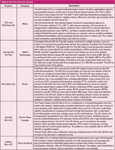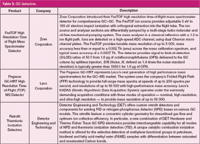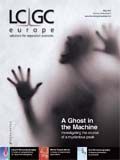New Gas Chromatography Products at Pittcon 2011
LCGC Europe
John Hinshaw reviews the new GC instruments and accessories that were on display at Pittcon 2011.
John Hinshaw reviews the new GC instruments and accessories that were on display at Pittcon 2011, which was held this March in Atlanta, Georgia.
The 62nd annual Pittsburgh Conference on Analytical Chemistry and Applied Spectroscopy (Pittcon), 13–18 March 2011 returned to Atlanta, Georgia, USA for the first time since 1997. I particularly enjoyed Atlanta for the Southern hospitality and food, easy access to and inside the Georgia World Congress Center, and the peach tree blossoms in Centennial Olympic Park. The conference exhibition floor provided some relief for weary aisle-walkers who took the time to hike to the far corners. There I found at various booths free fresh-baked chocolate chip cookies, coffee, croissants and a printed invitation to discuss the new (to me) but probably familiar field of "chromatology," a new type of chair for surviving trade shows (free demonstrations offered), the usual superhero costumes, and electrical massage demonstrations that had some of us jumping around like Luigi Galvani's 18th-century frogs.
Pittcon total attendance in 2011 increased to 17 199 — up about 300 from 2010. The number of exhibiting companies increased slightly too, as did the number of exhibitor booths. Next year, the Pittsburgh Conference will return to the Orange County Convention Center in Orlando, Florida, from 11–15 March 2012. If the next winter season is as inclement and extreme as this year's was, then the week's sojourn at this wandering conference's lowest altitude will be welcomed enthusiastically.
Overall, 2010–2011 was another strong year for gas chromatography (GC). A number of companies introduced new GC instruments, both for the laboratory and as portable systems. Rounded out by a significant number of new and improved automated sampling systems, high-performance mass spectrometric detectors, and clever time-saving accessories. This year's count of GC products is about even with each of the last two years, which shows that GC remains relatively immune to declining markets while showing significant growth in the high speed, miniature and micro, and portable areas.
This annual GC Connections instalment reviews GC instrumentation and accessories shown at this year's Pittcon or introduced during the previous year at conferences such as ASMS or Analytica. For a review of new GC and LC chromatography columns and related accessories, please see Column Watch in the March and April 2011 issues of LCGC North America. which are also available online at www.chromatographyonline.com.
The information presented here is based on manufacturers' replies to questionnaires, as well as on additional information from manufacturers' press releases, websites and product literature, and not upon actual use or experience of the author. During the conference, I took time to stroll around the convention aisles and see some of the new products firsthand as well as discover a number of items that weren't covered by the questionnaires.

Table 1: Companies listed.
Every effort has been made to collect accurate information, but due to the preliminary nature of some of the material LCGC Europe cannot be responsible for errors or omissions. This article cannot be considered to be a complete record of all new GC products shown at this year's Pittcon because not all manufacturers chose to respond to the questionnaire, nor is all of the submitted information included here due to the limited available space and the editors' judgment as to its suitability.
New GC Instruments
The trend in gas chromatography instruments at this year's Pittcon ran towards smaller size, reduced environmental impact, less carrier gas and power consumption and improved ease of use. A list of some of the new instuments on offer is shown in Table 2.

Table 2: New GC instrument systems.
The newest routine lab chromatographs featured high-efficiency oven insulation and smaller oven sizes that yield faster heating and cooling rates while using less power and supporting high speeds of analysis. The smaller mini- and micro-GCs, by their nature, consume less power and carrier gas in a smaller footprint; several were hand-portable.

Table 2: Continued
Last year's industry consolidations resulted in a number of new GC instrument announcements from companies such as Brucker (Bremen, Germany) Agilent Technologies (Santa Clara, California, USA) and Thermo Fisher Scientific (Waltham, Massachusetts, USA) based upon the models acquired last year.
One new company, Ellutia Chromatography Solutions (Charleston, South Carolina, USA) announced it was forming by unifying a group of three partner companies: Advanced Chromatography Systems, Cambridge Scientific Instruments and Unicam Chromatography. All told there were at least fourteen new GC instruments on display — a remarkable assortment for an allegedly mature technology.
Detector Developments
Two new time-of-flight (TOF) mass spectrometry detectors for GC stood out at this year's Pittcon. Offering the highest mass resolution and speeds in their class for demanding high-performance techniques such as high-speed GC or comprehensive GC×GC, TOF-MS detectors are ideal for a wide range of applications in environmental, petroleum, food and flavour, pharmaceuticals and others; where a mass spectrometry detector enhances compound identification and quantification beyond the capabilities of the separation system alone. In the more conventional detector vein, Detector Engineering and Technology (Walnut Creek, California, USA) offered a new series of their retrofittable thermionic detectors, including a unique catalytic combustion ionization method for the selective detection of methylene functional groups. A list of some of the new detectors on offer is shown in Table 3.

Table 3: GC detectors.
Sampling Systems
Sampling systems for GC saw increased activity, too. Agilent introduced a significant new development in headspace samplers with their model 7697A. The new design leverages their existing liquid autosampler's capabilities in a complete redesign of the company's previous workhorse headspace sampler.
Thermal desorption and pyrolysis took centre stage too, with new products from Frontier Laboratories (Fukushima, Japan), Gerstel (Mülheim an der Ruhr, Germany), and CDS Analytical (Oxford, Pennsylvania, USA) along with a new cannister sampling accessory from Markes International (Llantrisant, UK). The common thread among all of these was automated handling of gaseous samples from diverse sources. Gerstel also introduced an updated version of their MPS multipurpose sampling and sample preparation robot. A list of some of the new GC sampling products on offer is shown in Table 4.

Table 4: GC sampling.
Accessories
Two accessories for capillary GC users are listed here. The Restek Flip-Seal (Restek, Bellafonte, Pennsylvania, USA) for Agilent split/splitless inlets assists lower-seal maintenance and includes two useful seals in one part. From NLISIS (Eindhoven, The Neterlands) the Fuse capillary column connector accessory enhances column-to-column or pre-column connections.
Two new gas regulators were introduced with reduced contamination in mind. The AirGas regulator (AirGas, Radnor, Pennsylvania, USA) includes a new check-valve on the high pressure side to control tank and stream contamination with air or other gases in the regulator; Concoa (Virginia Beach, Virginia, USA) showed a regulator with inert metal surface treatment to reduce interaction with sensitive sample components. Analytical Flow Products (Thetford Mines, Quebec, Canada) had two designs of rotary gas sampling valve actuators, and both AirGas and Concoa exhibited high-performance high pressure analytical gas delivery manifolds.
Acknowledgment
I would like to thank the manufacturers and distributors that kindly furnished the requested information before, during, and after Pittcon 2011, allowing a timely report on new product introductions. For those manufacturers who did not receive a pre-conference questionnaire this year and would like to receive one and be considered for early inclusion into Pittcon 2012 coverage, please send the name of the primary company contact, the mailing address, fax number, and e-mail address to Alasdair Matheson, Editor, LCGC Europe, Advanstar Communications, 4A Bridgegate Pavillion, Chester Business Park, Wrexham Road, Chester CH4 9QH, UK or email amatheson@advanstar.com
GC Connections" editor John V. Hinshaw is senior research scientist at Serveron Corp., Hillsboro, Oregon, USA and a member of LCGC Europe's editorial advisory board. Direct correspondence about this column should go to the editor Alasdair Matheson, LCGC Europe, Advanstar Communications, 4A Bridgegate Pavillion, Chester Business Park, Wrexham Road, Chester CH4 9QH, UK or email amatheson@advanstar.com.
References
1. R. Majors, LCGC North America, 29(3), 218–235 (2011).
2. R. Majors, LCGC North America, 29(4) 300–316 (2011).

New Study Reviews Chromatography Methods for Flavonoid Analysis
April 21st 2025Flavonoids are widely used metabolites that carry out various functions in different industries, such as food and cosmetics. Detecting, separating, and quantifying them in fruit species can be a complicated process.
University of Rouen-Normandy Scientists Explore Eco-Friendly Sampling Approach for GC-HRMS
April 17th 2025Root exudates—substances secreted by living plant roots—are challenging to sample, as they are typically extracted using artificial devices and can vary widely in both quantity and composition across plant species.
Sorbonne Researchers Develop Miniaturized GC Detector for VOC Analysis
April 16th 2025A team of scientists from the Paris university developed and optimized MAVERIC, a miniaturized and autonomous gas chromatography (GC) system coupled to a nano-gravimetric detector (NGD) based on a NEMS (nano-electromechanical-system) resonator.

.png&w=3840&q=75)

.png&w=3840&q=75)



.png&w=3840&q=75)



.png&w=3840&q=75)











